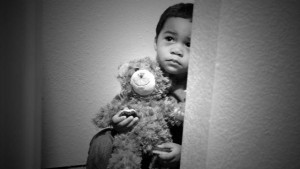Home » Commentary » Opinion » Stolen Generations taboo harms Indigenous children
· The Australian
 Alan Jones may have broken a taboo and outraged some with his comments about the Stolen Generations. But all the broadcaster was saying was repeating what many critics of indigenous child protection policies — Aboriginal and non-Aboriginal alike — have also claimed: that efforts to deal with the legacy of the Stolen Generations can get in the way of rescuing children in the most disadvantaged communities in the nation.
Alan Jones may have broken a taboo and outraged some with his comments about the Stolen Generations. But all the broadcaster was saying was repeating what many critics of indigenous child protection policies — Aboriginal and non-Aboriginal alike — have also claimed: that efforts to deal with the legacy of the Stolen Generations can get in the way of rescuing children in the most disadvantaged communities in the nation.
The well-meaning desire to avoid repeating the historic child removal practices that separated indigenous people from their families, their kin, and their culture can lead child protection authorities to keep indigenous children with their families — even if this means overlooking the sheer suffering these children experience due to parental and community dysfunction.
An insight into the harm done to children by this reluctance to remove is offered by the 2012 death of four year-old Aboriginal girl Kia Shillingsworth at Brewarrina Hospital from acute rheumatic pancarditis complicated by viral pneumonia. Or, as the coroner put it in the inquest report handed down in September last year, Kia died “like too many others in remote Aboriginal communities … of a disease of poverty at an early age.”
If how Kia died wasn’t shocking enough, even more appalling were the circumstances in which she lived her short life. Not surprisingly, Kia was a ‘known’ child. The NSW Department of Family and Community Services received reports expressing concern for Kia’s welfare, which detailed the usual litany of indigenous child welfare issues — physical and medical neglect, overcrowding in the family home, and inadequate supervision.
The long history of reports, combined with the medical evidence cataloguing her many throat infections and skin infections (boils, ulcers, abscesses and cellulitis) that almost certainly caused her fatal rheumatic heart disease, defied the family’s description of Kia as a “very happy, healthy and active girl”. Kia died because of the gross neglect she suffered and from which she was not saved.
Despite receiving four reports of neglect in 2012 alone about Kia and her family, FACS did not conduct an investigation to check on her and her siblings’ welfare. The coroner partly attributed this “wholly inadequate response” to staffing issues and inexperienced social workers operating in a remote, disadvantaged location.
But more revealing was evidence that FACS social workers actually tolerated the unacceptably poor living conditions of many children in remote communities — an attitude described as having grown “desensitised to the risk” due to the “extensiveness of the medical neglect or intergenerational abuse within those communities”. But these rationalisations are mutually exclusive; and the real question is why social workers would ignore overwhelming evidence of child neglect.
The answer is that many indigenous children suffer gross neglect — in plain sight of the authorities who are meant to protect them — because of what social workers have been taught about how they should deal with the legacy of the Stolen Generations. The ‘culturally aware’ approach they have been encouraged to adopt towards indigenous child protection encourages them to minimise the threats to children’s welfare to avoid having to remove those children.
These attitudes can be traced back to the influence of the 1996 Bringing Them Home ‘Stolen Generations’ report of the Australian Human Rights Commission.
The report claimed that racism had motivated the removal of Aboriginal children throughout the twentieth century because white, western, and culturally arrogant social workers had failed to properly understand Aboriginal culture. Because Aboriginal family practices, such as lax parental supervision, differed from the mainstream definition of the normal nuclear family, these practices had been labeled as neglectful and served as grounds for child removal.
The follow-up claim that cultural bias lay behind the continuing high levels of indigenous child removal downplayed the dysfunctionality in remote communities. Nevertheless, the Bringing Them Home analysis has had a lasting impact on the way social workers are urged to think about child protection matters involving indigenous children.
The 2007 Wood Special Commission of Inquiry into Child Protection Services in NSW warned that social workers “raised in Anglo-Celtic society may find it difficult to understand … the complexity of Aboriginal family and kinship relationship that are important for a child, and for making decisions about where the child should live, if he or she cannot live with parents.”
Such teachings have created powerful reasons why social workers might seek to explain away the problem of child neglect, and would prefer to view the evidence of this as somehow an expression of the uniqueness of Aboriginal culture deserving of respect. Not only does this allow for hard decisions about ‘stealing’ children to be dodged; it also prevents being perceived as culturally insensitive at best, or branded racist at worst. The outcome, though, is that indigenous children are left in circumstances from which they should be removed.
Alan Jones irritates many by saying things that many people don’t want to hear. But he has expressed an uncomfortable truth about the role the legacy of the Stolen Generations plays in the perpetuation of indigenous child abuse. Rethinking how we deal with that legacy needs to be the twenty-first century version of the “whispering in our hearts”, if we are to properly address indigenous disadvantage and suffering.
Jeremy Sammut is a research fellow at The Centre for Independent Studies and author of The Madness of Australian Child Protection: Why Adoption Will Rescue Australia’s Underclass Children (Connor Court).
Image via @KasadyMoser
Stolen Generations taboo harms Indigenous children